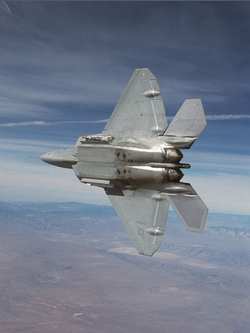Delays, Missed Cost Targets, Make GAO Recommend 'Go Slow'
The Government Accounting Office is skeptical about the
F/A-22 Raptor. In its recently-released report, it tells us why, as
these verbatim excerpts show [emphases added]:
 The
Air Force is developing the F/A-22 aircraft to fly at higher speeds
for longer distances, be less detectable, and improve the
pilot’s awareness of the surrounding situation. The F/A-22
will replace the Air Force’s existing fleet of F-15 aircraft.
Over the past several years the program has experienced significant
cost overruns and schedule delays.
The
Air Force is developing the F/A-22 aircraft to fly at higher speeds
for longer distances, be less detectable, and improve the
pilot’s awareness of the surrounding situation. The F/A-22
will replace the Air Force’s existing fleet of F-15 aircraft.
Over the past several years the program has experienced significant
cost overruns and schedule delays.
Congress mandated that GAO assess the development program and
determine whether the Air Force is meeting key performance,
schedule, and cost goals. GAO also assessed the implications of the
progress of the development program on production.
The F/A-22 development program did not meet key
performance, schedule, and cost goals in fiscal year 2002, and
delays in the flight test program have led to an increase in the
development cost estimate of $876 million. In response to
this increase, DOD restructured the development program and reduced
production aircraft by 27. If additional delays occur, further
changes may be required. The program also continues to address
technical problems that have limited the performance of test
aircraft, including violent movement or "buffeting" of the vertical
fins, overheating in portions of the aircraft, weakening of
materials in the horizontal tail, and instability of avionics
software. Air Force officials cannot predict when they will resolve
these problems. These technical problems, along with the late
delivery of aircraft to the flight test center, have delayed the
development program.
Based on F/A-22 flight test accomplishment data and current
flight test plans, we believe that operational testing will likely
be delayed several months beyond the planned August 2003 start
date.
 The F/A-22 program is in its final stages of
development, and low-rate initial production has begun. Since
fiscal year 1997, funds have been appropriated to acquire
production aircraft, and the F/A-22 acquisition plan calls for
steadily increasing annual production rates. However, GAO considers
the Air Force’s acquisition strategy at high risk for
increases in production costs.
The F/A-22 program is in its final stages of
development, and low-rate initial production has begun. Since
fiscal year 1997, funds have been appropriated to acquire
production aircraft, and the F/A-22 acquisition plan calls for
steadily increasing annual production rates. However, GAO considers
the Air Force’s acquisition strategy at high risk for
increases in production costs.
In past reports, GAO has reported that acquiring aircraft while
significant technical challenges remain does not allow for adequate
testing of the aircraft. The uncertainties regarding performance
capabilities of the F/A-22 aircraft and its development schedule
will persist until technical problems have been addressed,
including testing of modifications or fixes necessary to
potentially alleviate these problems. In light of those
uncertainties, steadily increasing annual production rates could
result in the Air Force having to modify a larger quantity of
aircraft after they are built.
 To
help minimize the risks of producing large quantities of aircraft
that may require costly modifications, GAO
recommends that the Secretary of Defense
To
help minimize the risks of producing large quantities of aircraft
that may require costly modifications, GAO
recommends that the Secretary of Defense
- reconsider the decision to increase the annual production rate
beyond 16 aircraft until greater knowledge on any need for
modifications is established through completion of operational
testing and
- update the 2002 risk assessment and certification with
sufficient detail to allow verification of the conclusions.
In comments on a draft of this report, the Department of Defense
(DOD) stated that it agreed, for the most part, with our
description of the current state of the F/A-22 program’s
content, schedule and cost. However, DOD did not concur with our
recommendation.
 Airbus Racer Helicopter Demonstrator First Flight Part of Clean Sky 2 Initiative
Airbus Racer Helicopter Demonstrator First Flight Part of Clean Sky 2 Initiative Diamond's Electric DA40 Finds Fans at Dübendorf
Diamond's Electric DA40 Finds Fans at Dübendorf ANN's Daily Aero-Term (04.23.24): Line Up And Wait (LUAW)
ANN's Daily Aero-Term (04.23.24): Line Up And Wait (LUAW) NTSB Final Report: Extra Flugzeugbau GMBH EA300/L
NTSB Final Report: Extra Flugzeugbau GMBH EA300/L Classic Aero-TV: 'Never Give Up' - Advice From Two of FedEx's Female Captains
Classic Aero-TV: 'Never Give Up' - Advice From Two of FedEx's Female Captains





